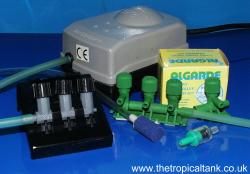|
|
Air pumps and aeration
|
Air pumps can be used in two main ways in the aquarium: either to power small internal
filters and undergravel filters (UGF) or for aeration only, using
airstones. When used to run UGF (by placing the airline in the uplift tube), an airstone
should be attached to increase the number of bubbles and hence water movement.
|
|
It is not really the air bubbles themselves which aerate the water per se, it is the circulation and surface
turbulence that they create. Good circulation in an aquarium can be important for several reasons, but one
of them is to circulate the water up to the surface where it will interact with the air to pick up
oxygen - this is why surface turbulence increases the aeration/oxygenation of the water.
|
 |
|
Note that in an
aquarium with good circulation, additional aeration should not normally be necessary. In planted aquaria it is
actually undesirable, as it will cause more of the CO2 on which plants rely to be lost from the water.
There are occasions where it may be desirable to increase oxygenation however. One of these is when the
temperature of the aquarium is higher than normal, due to high ambient temperature. There will be less oxygen
dissolved in the water as the temperature increases, so it is important to maximise aeration in a warmer tank.
|
|
Airpumps come in a range of sizes to suit different size aquariums and accessories. Some are provided
with twin outlets, while others have adjustable flow. Control valves, T-pieces, etc. can be used to
divide the flow to several aeration devices.
|
 |
|
An airpump should normally be placed above the level of the aquarium, so that in the event of a power
failure, water will not drain back into the pump and damage it. If the airpump is placed below the
aquarium, a non-return valve should be fitted into the tubing line, which will tend to reduce flow slightly.
|
|
Note that you should not restrict the flow from an air pump, as this is likely to damage it. If you
are using a larger airpump to run just one airstone for example, you should use a double valve so that
the 'excess' air can be bled to the room.
|
[Home]
[Article Library]
[Fish Index]
[Tank Setups]
[Forum]
[Site Map]
|
|
|




